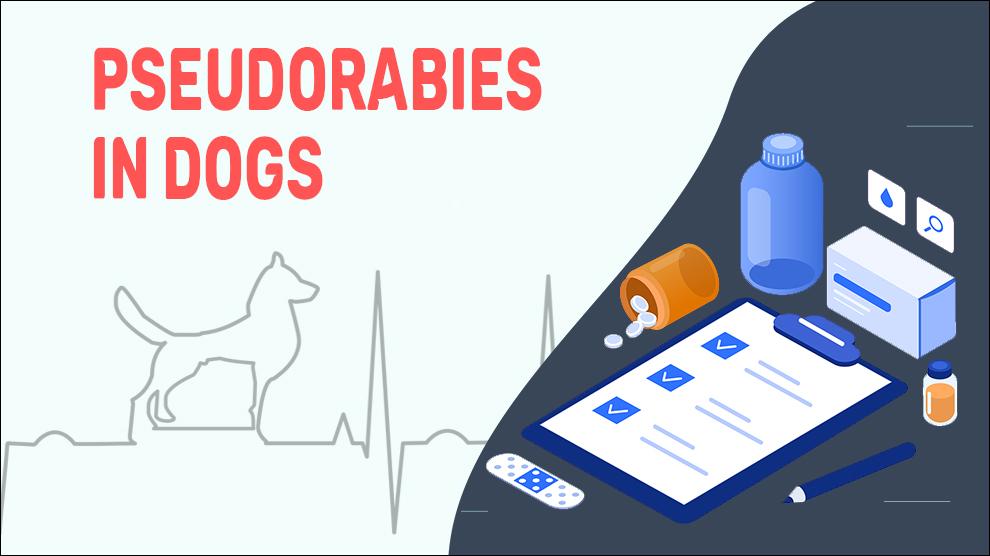Pseudorabies, although the name is misleading and has nothing to do with rabies, it is a highly fatal disease found in dogs, especially those that come into contact with swine. This is caused by a porcine suid herpesvirus 1 (SHV1) whose natural hosts are pigs. As the clinical signs caused by this virus resemble those of rabies, it is called pseudo-rabies.
The neurotrophic alpha-herpesvirus gets transmitted when the dogs come in contact with pigs’ direct and fecal-oral contact with pigs, by eating swine offals, uncooked meat, or contaminated foods, or by ingestion from infected rats.
This is also called mad itch, infectious bulbar paralysis, and Aujezsky's disease. The incubation period in puppies is 3 to 6 days, after which clinical signs develop or sudden death occurs.
After ingestion or inhalation, SHV-1 virus replication happens in the oropharynx. The virus reaches sensory nerve endings and travels to the sensory nerve ganglia by retrograde axonal transport and ultimately to the central nervous system (CNS). Infection also affects the cardiac autonomic plexus (ganglioneuritis) with associated degeneration of intestinal myenteric ganglia and myocardial degeneration.
Symptoms Of Pseudorabies
General symptoms:
- Hypersalivation
- Fever
- Vomiting
- Lethargy
- Rapid and labored breathing
- Dysphagia
- Muscle stiffness
- Ataxia
- Tachypnea or respiratory distress
Gastrointestinal signs:
- Vomiting
- Diarrhea
- Hematemesis
- Melena
Neurologic symptoms:
- Loss of muscle control
- Depression/Lethargy
- Convulsions
- Lying down excessively/Reluctance to move
- Self-mutilation from scratching due to Intense itching
Treatment Options For Pseudorabies
There is no specific treatment available for infectious canine hepatitis in dogs.
- Immediate hospitalization and close monitoring are required as this virus, if not treated immediately, will cause death.
- Intravenous fluid and nutritional therapy will be given to help your dog not become severely dehydrated.
- Your vet keeps your dog hydrated and only treats the symptoms while the virus runs its course.
- Immunosuppressive or anti-inflammatory medications.
- Anti-diarrhea medications.
- A broad-spectrum antibiotic for any secondary bacterial infections from occurring.
Home Remedies For Pseudorabies
Immunocompromised dogs or those with weaker immune systems may not survive the early respiratory stages. Meanwhile, stronger dogs may recover but they develop neurological signs that may last for their lifetime.
Discuss home treatments with your vet to ensure there won’t mess with other medications.
This may include dietary changes, exercise, supplements to administer, and other holistic treatments.
Prevention Of Pseudorabies
- While the best prevention is to avoid high-risk locations or contact with an infected animal that is not always possible.
- Herding dogs’ access to the feeding areas should be restricted, including pastures should be reduced.
- Do not allow dogs to ingest raw meats from suspected sources.
- Regular health checks are recommended to ensure there are no secondary infections.
Affected Breeds Of Pseudorabies
There is no breed disposition.
Additional Facts For Pseudorabies
1. Causes:
- The incubation period in pigs is 90 to 150 days and clinical signs are seen after 5 to 10 days post-infection.
- The virus will be present in nasal secretions, milk, tonsillar tissue, and urine of swine.
- Contaminated drinking water and feed buckets will contribute to the spread.
- People can carry the virus on their clothing, footwear or skin after contact with pigs.
- When the conditions are right, the virus can endure for a few days in the environment, mostly in soil, grass, feces, and shelled corn.
- It is an aerosolized virus meaning it can be transmitted via inhalation in close proximity to the infected animal.
2. Types:
- Classic or typical pseudorabies - The fatal condition lasts 24 to 36 hours for 60 percent of cases.
- Atypical pseudorabies - The condition is a little prolonged for more than 36 hours; however, it is invariably lethal.
3. Mortality:
Pseudorabies has a high fatality rate, particularly for puppies which is 100%.
4. Diagnosis:
- Complete blood count, chemistry panel
- Urinalysis
- Virus isolation
- PCR fluorescent antibody testing
- Serologic testing - (ELISA, latex agglutination, and serum neutralization)
5. Prognosis:
Treatment is usually ineffective and most infected puppies die suddenly before any medical intervention can be provided. Antiviral drug therapy is generally unproductive. Preventative measures are the only way of protection.
When To See A Vet
Contact your vet right away, if you notice any of the following:
- Hyper salivation
- Hematemesis
- Lying down excessively/Reluctance to move
- Intense itching
Food Suggestions For Pseudorabies
- Leafy greens (Spinach, Kale, lettuce)
- High-quality protein (seafood, meat, dairy, or eggs)
- Essential fatty acids (egg yolks, oatmeal)
- Broth or stock of boiled chicken bones
- Tuna, salmon, cod, whiting, whitefish, trout, mackerel, sardines, and herring
- Button Mushrooms, Oysters
- Cooked or raw liver, Red Meat
- Plant-based proteins peas, chickpeas, lentils
- Canned pumpkin, Carrots
- Berries, apples, banana
Conclusion
Prevention is the key to addressing pseudorabies. Around 50% of adult dogs that get infected and that are treated quickly will survive the infection. However, most of the infected puppies will not survive the infection.
Breeders and pet owners must remain cautious with pseudorabies prevention protocols to reduce the risk of an outbreak.

















